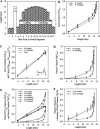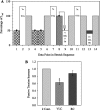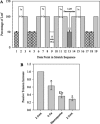Rhythmic contraction generates adjustable passive stiffness in rabbit detrusor
- PMID: 20056849
- PMCID: PMC3774559
- DOI: 10.1152/japplphysiol.01079.2009
Rhythmic contraction generates adjustable passive stiffness in rabbit detrusor
Abstract
The length-tension (L-T) relationships in airway and vascular smooth muscles have been shown to adapt with length changes over time. Our prior studies have shown that the active and passive L-T relationships in rabbit detrusor smooth muscle (DSM) can adapt and that DSM exhibits adjustable passive stiffness (APS) characterized by a passive L-T curve that is a function of strain and activation history. The present study demonstrates that passive tension due to APS can represent a substantial fraction of total tension over a broad length range. Our previous studies have shown that maximal KCl-induced contractions at short muscle lengths generate APS that is revealed by increased pseudo-steady-state passive tension at longer lengths compared with previous measurements at those lengths. The objective of the present study was to determine the mechanisms involved in APS generation. Increasing the number of KCl-induced contractions or the duration of a contraction increased the amount of APS generated. Furthermore, a fraction of APS was restored in calcium-free solution and was sensitive to the general serine and threonine protein kinase inhibitor staurosporine. Most importantly, rhythmic contraction (RC) generated APS, and because RC occurs spontaneously in human bladder, a physiological role for RC was potentially identified.
Figures








Similar articles
-
Adjustable passive stiffness in mouse bladder: regulated by Rho kinase and elevated following partial bladder outlet obstruction.Am J Physiol Renal Physiol. 2012 Apr 15;302(8):F967-76. doi: 10.1152/ajprenal.00177.2011. Epub 2011 Dec 28. Am J Physiol Renal Physiol. 2012. PMID: 22205227 Free PMC article.
-
Evidence that actomyosin cross bridges contribute to "passive" tension in detrusor smooth muscle.Am J Physiol Renal Physiol. 2010 Jun;298(6):F1424-35. doi: 10.1152/ajprenal.00635.2009. Epub 2010 Apr 7. Am J Physiol Renal Physiol. 2010. PMID: 20375119 Free PMC article.
-
Adaptation of the length-active tension relationship in rabbit detrusor.Am J Physiol Renal Physiol. 2009 Oct;297(4):F1119-28. doi: 10.1152/ajprenal.00298.2009. Epub 2009 Aug 12. Am J Physiol Renal Physiol. 2009. PMID: 19675182 Free PMC article.
-
ROK-induced cross-link formation stiffens passive muscle: reversible strain-induced stress softening in rabbit detrusor.Am J Physiol Cell Physiol. 2005 Jul;289(1):C12-21. doi: 10.1152/ajpcell.00418.2004. Epub 2005 Feb 16. Am J Physiol Cell Physiol. 2005. PMID: 15716326
-
Adjustable passive length-tension curve in rabbit detrusor smooth muscle.J Appl Physiol (1985). 2007 May;102(5):1746-55. doi: 10.1152/japplphysiol.00548.2006. Epub 2007 Jan 18. J Appl Physiol (1985). 2007. PMID: 17234807
Cited by
-
What are the origins and relevance of spontaneous bladder contractions? ICI-RS 2017.Neurourol Urodyn. 2018 Jun;37(S4):S13-S19. doi: 10.1002/nau.23485. Epub 2018 Jan 23. Neurourol Urodyn. 2018. PMID: 29360173 Free PMC article. Review.
-
A pilot study to measure dynamic elasticity of the bladder during urodynamics.Neurourol Urodyn. 2017 Apr;36(4):1086-1090. doi: 10.1002/nau.23043. Epub 2016 May 31. Neurourol Urodyn. 2017. PMID: 27241067 Free PMC article.
-
Adjustable passive stiffness in mouse bladder: regulated by Rho kinase and elevated following partial bladder outlet obstruction.Am J Physiol Renal Physiol. 2012 Apr 15;302(8):F967-76. doi: 10.1152/ajprenal.00177.2011. Epub 2011 Dec 28. Am J Physiol Renal Physiol. 2012. PMID: 22205227 Free PMC article.
-
New Diagnostics for Male Lower Urinary Tract Symptoms.Curr Bladder Dysfunct Rep. 2019 Jun;14:90-97. doi: 10.1007/s11884-019-00511-0. Epub 2019 May 3. Curr Bladder Dysfunct Rep. 2019. PMID: 31938079 Free PMC article.
-
Evidence for a common mechanism for spontaneous rhythmic contraction and myogenic contraction induced by quick stretch in detrusor smooth muscle.Physiol Rep. 2013 Nov;1(6):e00168. doi: 10.1002/phy2.168. Epub 2013 Nov 22. Physiol Rep. 2013. PMID: 24400167 Free PMC article.
References
-
- Anderson KE, Arner A. Urinary bladder contraction and relaxation: physiology and pathophysiology. Physiol Rev 84: 935–986, 2004 - PubMed
-
- Bai TR, Bates JH, Brusasco V, Camoretti-Mercado B, Chitano P, Deng LH, Dowell M, Fabry B, Ford LE, Fredberg JJ, Gerthoffer WT, Gilbert SH, Gunst SJ, Hai CM, Halayko AJ, Hirst SJ, James AL, Janssen LJ, Jones KA, King GG, Lakser OJ, Lambert RK, Lauzon AM, Lutchen KR, Maksym GN, Meiss RA, Mijailovich SM, Mitchell HW, Mitchell RW, Mitzner W, Murphy TM, Paré PD, Schellenberg RR, Seow CY, Sieck GC, Smith PG, Smolensky AV, Solway J, Stephens NL, Stewart AG, Tang DD, Wang L. On the terminology for describing the length-force relationship and its changes in airway smooth muscle. J Appl Physiol 97: 2029–2034, 2004 - PubMed
-
- Biers SM, Reynard JM, Doore T, Brading AF. The functional effects of a c-kit tyrosine inhibitor on guinea-pig and human detrusor. BJU Int 97: 612–616, 2006 - PubMed
-
- Bossé Y, Sobieszek A, Pare PD, Seow CY. Length adaptation of airway smooth muscle. Proc Am Thorac Soc 5: 62–67, 2008 - PubMed
-
- Brading AF. A myogenic basis for the overactive bladder. Urology 50: 57–67, 1997 - PubMed
Publication types
MeSH terms
Substances
Grants and funding
LinkOut - more resources
Full Text Sources
Miscellaneous

